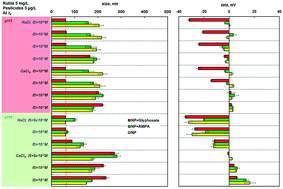当前位置:
X-MOL 学术
›
Environ. Sci.: Nano
›
论文详情
Our official English website, www.x-mol.net, welcomes your
feedback! (Note: you will need to create a separate account there.)
Investigations into titanium dioxide nanoparticle and pesticide interactions in aqueous environments
Environmental Science: Nano ( IF 5.8 ) Pub Date : 2017-08-30 00:00:00 , DOI: 10.1039/c7en00445a Svetlana M. Ilina 1, 2 , Patrick Ollivier 1, 2 , Danielle Slomberg 3, 4, 5, 6, 7 , Nicole Baran 1, 2 , Anne Pariat 3, 4, 5, 6, 7 , Nicolas Devau 1, 2 , Nicole Sani-Kast 8, 9, 10 , Martin Scheringer 8, 9, 10, 11, 12 , Jérôme Labille 3, 4, 5, 6, 7
Environmental Science: Nano ( IF 5.8 ) Pub Date : 2017-08-30 00:00:00 , DOI: 10.1039/c7en00445a Svetlana M. Ilina 1, 2 , Patrick Ollivier 1, 2 , Danielle Slomberg 3, 4, 5, 6, 7 , Nicole Baran 1, 2 , Anne Pariat 3, 4, 5, 6, 7 , Nicolas Devau 1, 2 , Nicole Sani-Kast 8, 9, 10 , Martin Scheringer 8, 9, 10, 11, 12 , Jérôme Labille 3, 4, 5, 6, 7
Affiliation

|
The influence of three pesticides (glyphosate, aminomethylphosphonic acid (AMPA) and 2,4-dichlorophenoxyacetic acid (2,4-D)) on the colloidal fate of TiO2 nanoparticles (NPs; anatase and rutile) has been investigated under aqueous conditions of variable chemical composition (Na+ or Ca2+), ionic strength (IS, 10−4–10−1 M), and pH (5 or 8). Sorption and degradation of these pesticides in the presence of the NPs were evaluated. In the absence of the pesticides, increasing IS, the presence of the divalent cation Ca2+ and a pH value close to the NP isoelectric point favored NP homoaggregation as expected. However, at low IS (≤10−2 M in NaCl; ≤10−3 M in CaCl2), in the presence of a few μg L−1 of glyphosate and rutile in the mg L−1 range, NP homoaggregation was prevented, despite the pH = 5 close to the NP isoelectric point (4.0–4.2). The phosphonate group of the pesticide drove glyphosate adsorption onto the NP, while the carboxylic group was responsible for the electrostatic stabilization of the NP. The stabilizing effect of glyphosate on NP aggregation however appears to be temporary. Furthermore, TiO2 NPs also adsorbed AMPA and promoted degradation of glyphosate to AMPA. These results highlight new evidence of NP–pesticide interactions and the differences in their fate and potential co-migration behavior in aquatic environments.
中文翻译:

在水环境中研究二氧化钛纳米粒子与农药的相互作用
研究了三种农药(草甘膦,氨基甲基膦酸(AMPA)和2,4-二氯苯氧基乙酸(2,4-D))对TiO 2纳米颗粒(NPs,锐钛矿和金红石)胶体命运的影响。可变的化学成分(Na +或Ca 2+),离子强度(IS,10 -4 –10 -1 M)和pH(5或8)。评估了这些农药在NP存在下的吸附和降解。在不使用农药的情况下,如预期的那样,IS的增加,二价阳离子Ca 2+的存在和接近NP等电点的pH值有利于NP均聚。然而,在低IS(≤10 -2 M在氯化钠;≤10 -3M在CaCl 2中),在存在几微克L -1的草甘膦和金红石在mg L -1范围内时,尽管pH = 5接近NP等电点(4.0-4.2),但仍防止了NP均聚。农药的膦酸酯基使草甘膦吸附到NP上,而羧基则负责NP的静电稳定。草甘膦对NP聚集的稳定作用似乎只是暂时的。此外,TiO 2 NP也吸附AMPA并促进草甘膦降解为AMPA。这些结果凸显了NP-农药相互作用的新证据,以及它们在水生环境中的命运和潜在的共迁移行为的差异。
更新日期:2017-10-13
中文翻译:

在水环境中研究二氧化钛纳米粒子与农药的相互作用
研究了三种农药(草甘膦,氨基甲基膦酸(AMPA)和2,4-二氯苯氧基乙酸(2,4-D))对TiO 2纳米颗粒(NPs,锐钛矿和金红石)胶体命运的影响。可变的化学成分(Na +或Ca 2+),离子强度(IS,10 -4 –10 -1 M)和pH(5或8)。评估了这些农药在NP存在下的吸附和降解。在不使用农药的情况下,如预期的那样,IS的增加,二价阳离子Ca 2+的存在和接近NP等电点的pH值有利于NP均聚。然而,在低IS(≤10 -2 M在氯化钠;≤10 -3M在CaCl 2中),在存在几微克L -1的草甘膦和金红石在mg L -1范围内时,尽管pH = 5接近NP等电点(4.0-4.2),但仍防止了NP均聚。农药的膦酸酯基使草甘膦吸附到NP上,而羧基则负责NP的静电稳定。草甘膦对NP聚集的稳定作用似乎只是暂时的。此外,TiO 2 NP也吸附AMPA并促进草甘膦降解为AMPA。这些结果凸显了NP-农药相互作用的新证据,以及它们在水生环境中的命运和潜在的共迁移行为的差异。











































 京公网安备 11010802027423号
京公网安备 11010802027423号